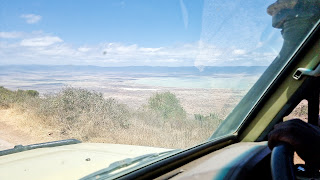Ngorongoro crater Tanzania
Got up at 3.00 am to be ready at 4.20am to go out for Hot air Ballon safari in Serengeti National Reserve park. On the way to the take off point we were lucky to see a lions drinking water and crossing the mud road. A little distance further it was a chance to see a pack of hyenas. These are apart from lots of wilder beests and zebras gazelles crossing in front of our vehicles.
But the Ballon didn't raise up despite the captain trying his level best. We were dragging for around 700mts before it had to be aborted.
But after a sumptuous breakfast provided by the hot Air Ballon group we left on a long drive through muddy rough road with so much mud around that by the end of the day everything from our head to toe, mobile phones, our baggage everything was covered with fine dust.
Reached Ngorongoro crater with much difficulty and out of 8 vans there were constant vehicle breakdowns.
We drove down into the crater while is volcanic and all the big five and numerous other animals and birds have made it their home the center is filled with water and there is a lot if water and vegetation to support the animals
Ngorongoro Crater, extinct volcanic caldera in the Eastern (Great) Rift Valley, northern Tanzania. It lies 75 miles (120 km) west of the town of Arusha. The caldera measures between 10 and 12 miles (16 and 19 km) across and has an area of 102 square miles (264 square km). Its heavily forested rim rises 2,000 feet (610 metres) above the caldera’s floor to an elevation of 7,500 feet (2,286 metres). Ngorongoro is thought to have formed about 2.5 million years ago from a large active volcano whose cone collapsed inward after a major eruption, leaving the present vast, unbroken caldera as its chief remnant.
The caldera’s floor is predominantly open grassland. It is home to a diverse array of animals including elephants, black rhinoceroses, leopards, buffalo, zebras, warthogs, gnu (wildebeests), Grant’s and Thomson’s gazelles, and the densest population of lions in the world. The local Masai people also graze their livestock in the crater. Lake Magadi, a shallow soda lake ringed by extinct volcanoes, is renowned as a habitat for great flocks of pink flamingos.















Comments